If you’re reading this article, then the chances are that you enjoy pizza. And who can blame you? It’s almost impossible to resist a hot slice of pizza with its soft (yet slightly crunchy) crust, long stands of fresh mozzarella cheese, the fresh flavor of homemade tomato sauce, and your favorite savory toppings… I’m getting hungry just writing this!
While most people are busy discussing age-old debates about whether or not pineapple goes on pizza, what type of pepperoni is the best for pizza, how much cheese you should put on pizza, and what the best tomato sauce recipe is, the real pizza fans know what the most important part of the recipe is. The fact is if you were to ask most professional pizza chefs what the most important part of their pizza recipe is, they wouldn’t talk about the toppings; they would tell you it’s the dough!
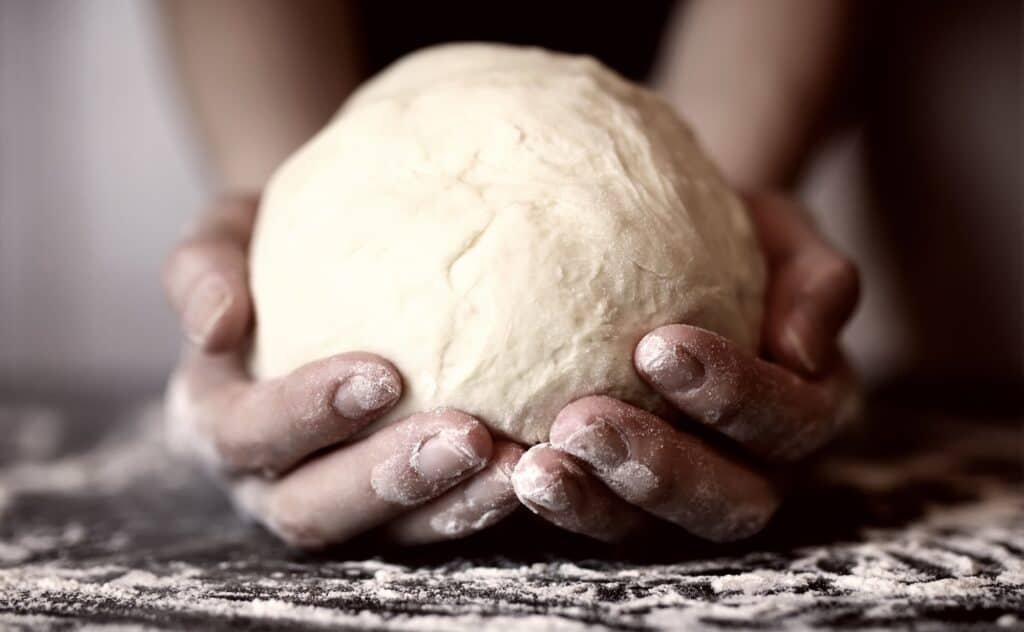
Although Americans tend to be more concerned about what toppings go on their pizza, traditional pizzas such as the Neapolitan-style pie are centered around a simple, high-quality dough recipe. In fact, the quality of the dough is so central to traditional pizza making that most chefs would throw the entire pizza out if something was wrong with the dough.
Pizza Dough Origins…
The history of pizza dough goes back quite a long way. It all traces back to traditional styles of making flatbread. The flatbread was incredibly common around the Mediterranean area (and still is). To this day, you’ll still see forms of flatbread used in Greek cuisine.
Modern-day Italy is known for having some of the Mediterranean region’s best farmland, and as a result, tomatoes and dairy agriculture flourished. Tomatoes and cheese were both very common foods in Italy. It wasn’t long before the first Italians started combining tomato sauces with fresh cheese and using them as toppings for their warm, oven-baked flatbreads. And so, Italy became the birthplace of pizza.
Since then, the wonderful food has spread across the world. You can find pizza in just about every major country to some small degree. In fact, many cultures even put their own personal twist on the meal, customizing pizzas with toppings from their home countries. And although modern-day American pizza is quite different from the original artisan pizzas of old, pizza is just as popular as it’s ever been.
40 Questions, Answers, and Facts About Pizza Dough
When pizzerias temporarily shut down during the recent pandemic, kitchen-savvy pizza fanatics like myself had to learn how to make our own pizza. This meant that I had to learn and practice my own dough-making skills. In the process, I learned a lot about pizza dough. It wasn’t long before people started realizing my knowledge and I found myself answering a million different questions.
So, I decided that the best course of action was simply to read through all of my messages, pick out the most common and important questions about pizza dough, and then answer them all in one place. Below, I’ve taken the liberty of sharing 40 of the most common questions I’ve received along with my detailed answers for each one. Whether you have a pressing question about pizza dough or you just want to learn more about pizza, I guarantee you’ll find all of the answers you need below. Let’s take a look!
1. Is Making Your Own Pizza Dough Hard?
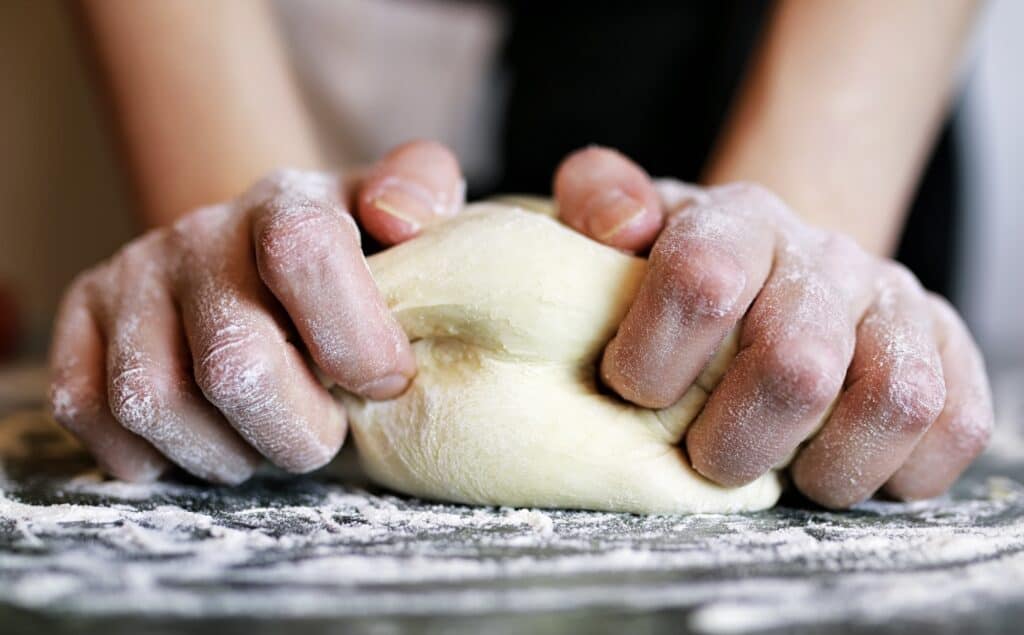
If you’re tired of heating up store-bought pizzas in your conventional or microwave oven, then you’ve probably considered making your own pizza dough before. When I first went into quarantine, I practically lived off of frozen pizzas. Needless to say, I got tired of that real quick. That’s when I started making my own pizza dough.
Making your own pizza dough is actually remarkably simple and relatively easy. The recipe for pizza dough is one of the easiest to follow and only requires limited ingredients. As long as you follow your pizza dough recipe and make sure that you complete all of the steps, you’ll have your own delicious, homemade pizza dough.
2. What Type Of Flour Is Used For Pizza Dough?
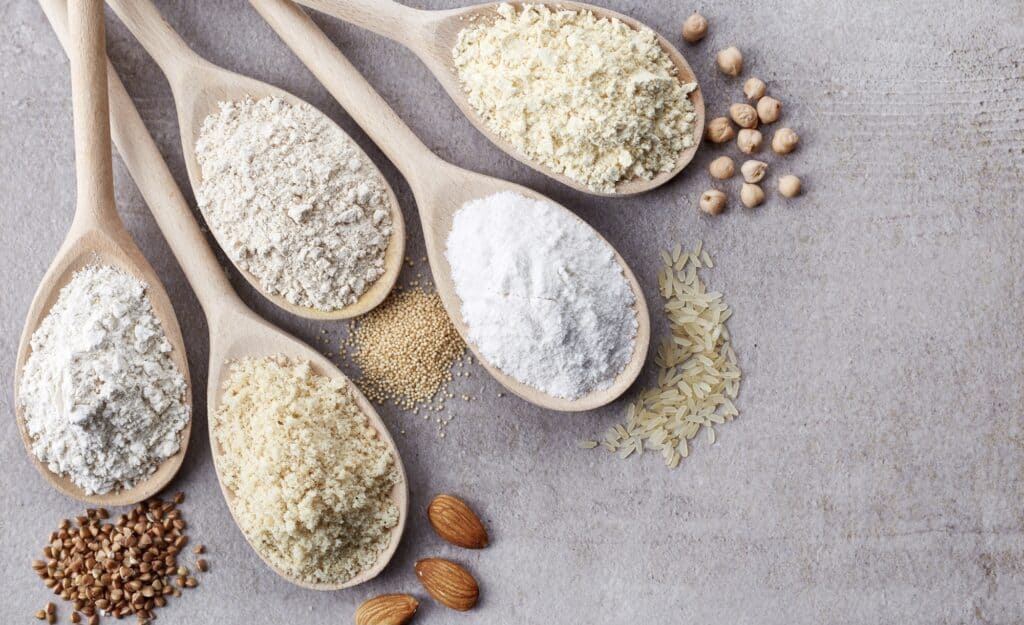
Flour is the most voluminous ingredient in your pizza dough recipe. This means that if you use the wrong type of flour, then you’ll end up with a completely different pizza dough than what you expected. Thankfully, the flour used for pizza dough also happens to be the most commonly found on grocery store shelves.
You should use all-purpose flour for making pizza dough. All-purpose flour is designed to rise slightly in the presence of yeast and water (the two other main ingredients). Using all-purpose flour will result in that flaky, crunchy, delicious pizza crust that you’re used to.
3. How Do You Tell If Pizza Dough Is Bad?
Perhaps you have some pizza dough that’s been sitting in your fridge for just over the 2-week mark. I’ve been in this same situation before, and thankfully, there’s a relatively simple and easy way to tell whether or not your pizza dough has gone bad.
The easiest way to tell if your pizza dough is bad is to smell it. As the yeast feeds on the sugars in the dough, it will produce alcohol. After two weeks, this can result in the dough smelling very sour, like old alcohol.
4. Does Pizza Dough Need Sugar?
If you’ve ever had a “sweet” slice of pizza, then you’ve probably wondered whether or not the bakers use sugar in their dough recipe. When I first tasted sweet dough, I thought my mind was playing tricks on me. However, as it turns out, adding sugar is a fairly common practice among pizza makers.
Pizza dough does not need sugar. The simplest Neapolitan and New York-style pizza dough recipes don’t have any sugar at all. However, some chefs do choose to add a pinch of sugar to their dough. The advantage of adding sugar is that it creates a sweeter crust and helps the crust develop its distinctive brown color.
5. How Many Calories Does Pizza Dough Have?
Pizza dough has 137 calories per serving. This is assuming that you’re using a simple recipe containing flour, yeast, water, and a bit of olive oil. One “serving” of pizza dough is equivalent to about one medium-sized slice of pizza once it’s finished baking.
No matter how much we love pizza, we all have to admit that it doesn’t score too high on the list of healthy foods. It’s just bread, cheese, tomatoes, and toppings. If you break it down nutritionally, it’s essentially just carbohydrates, acidic fruit, fat, and a bit of protein. As long as you control your pizza intake, though, you shouldn’t have anything to worry about.
6. Can You Add Seasoning To Pizza Dough?
Yes! In fact, almost all pizza dough recipes require a pinch of salt to add to the flavor of the dough. If you’d like to further enhance the flavor of your pizza crust, then you can add other seasonings such as oregano, rosemary, thyme, or even parsley to your dough before adding your toppings and placing it in the oven.
Most traditionalists will caution you against adding too much seasoning to the dough as they claim that it takes away from the traditional taste of pizza. However, I’ve personally experimented by adding rosemary and oregano and have been incredibly pleased with the results. Just don’t add too much! A small pinch goes a long way when it comes to these potent herbs.
7. How Is Cheese-Stuffed Crust Pizza Dough Made?

Whether you’ve eaten Digiorno frozen pizza or you’ve had the pleasure of going to a more modern pizzeria, then you’ve probably tried a cheese-infused pizza crust at least once or twice in your life. While I don’t eat cheese-stuffed pizzas all the time, they are my guilty pleasure from time to time. I’ve even made my own a couple of times!
To make a cheese-stuffed pizza crust, follow your usual pizza dough recipe. Once you finish rolling, kneading, and stretching the dough into a circle, you’ll want to place a small ring of mozzarella cheese around the outer ring of the dough. Make sure to leave about 1.5-inches of space between the cheese and outer edge. Then, fold the pizza dough over the ring of cheese you just made!
As the pizza starts to bake, the fresh cheese will be sealed inside of the “dough blanket” that you folded over it. When you take the pizza out of the oven, you’ll have your very own cheese-stuffed pizza crust. I like to eat the slice and then use the crust as a breadstick and dip it in marinara sauce.
8. When Did Pizza Dough Come To America?
It is believed that the first pizza sold in America dates back to 1904 in Boston, Massachusetts. It was made by Giovanni and Gennaro Bruno, two Italian immigrants and brothers who hailed from Naples, Italy. They created America’s first recorded Neapolitan pizza and sold it in their small pizzeria.
One of the brothers eventually moved to Chicago and started his own pizzeria, creating the first “Chicago-style” pizza that quickly spread across the country and became one of the most popular street pizzas. It wasn’t long before the pizza craze hit America and small pizzerias popped up everywhere, each promising its own unique twist on the traditional Neapolitan pizza sold by Giovanni and Gennaro.
9. Should I Let My Pizza Dough Sit Overnight?
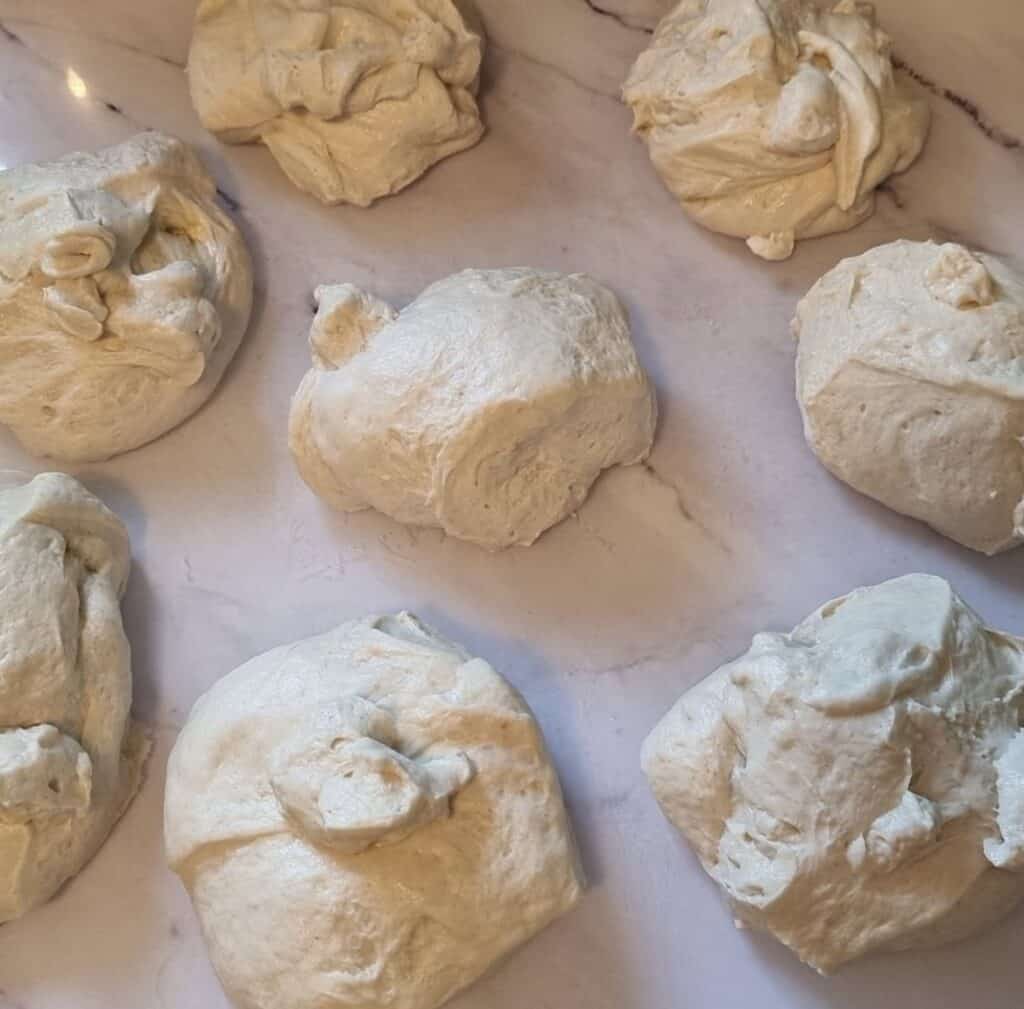
Proofing your dough is an essential part of creating great-tasting pizza. If you neglect to proof your dough for long enough, then it can result in a flat, chewy crust that’s more similar to pita bread than a crispy, flaky pizza crust. There are different methods for proofing pizza dough, but one of the most popular methods is overnight proofing.
If you want the most flavorful pizza dough possible, then you should “cold-proof” your pizza dough overnight. This process is relatively simple. Once your dough is completely mixed, place it in a bowl, cover it with plastic wrap, and then let it sit in the refrigerator for 24 hours.
10. What’s The Difference Between Cold-Proofing and Warm-Proofing?
The main difference between cold-proofing and warm-proofing is the amount of time that it takes for the dough to properly rise. When you proof the dough in a warmer environment, the dough rises faster (usually less than two hours). When you proof the dough in a cold environment, it rises slower (around 24 hours).
The longer the pizza dough sits, the better it will taste. This is why many pizza makers don’t mind waiting the extra time to cold-proof their dough. Some pizza makers even recommend cold-proofing your pizza dough for up to three days! You can warm-proof your pizza dough in less than two hours (at room temperature), but the resulting crust won’t be quite as flavorful as an overnight cold-proofed pizza dough.
11. What Region Did Pizza Dough Originate In?
Most historians and pizza lovers all agree that pizza, as we know it today, originated in the small city of Naples, Italy. Naples was an important trading hub and attracted individuals from all over the country, which helped pizza’s popularity spread throughout Italy. When the first Italian immigrants came to Boston in the United States, they brought their traditional Neapolitan-style pizza making with them!
Although the Neapolitan pizza was the first majorly popular pizza that was sold in the United States, other regions of Italy had their own unique methods of baking the flatbread pizza dough. Typically, the type of toppings that would be added to pizza depended on the local harvest of herbs and vegetables.
12. How Long Does Pizza Dough Need To Cook For?

As long as your pizza is a somewhat normal size (not oversized or a mini pizza), then your pizza should take between 10 and 15 minutes to finish cooking. Most pizza recipes recommend pre-heating your oven to 475-degrees Fahrenheit. Thicker doughs may take up to 15 minutes to cook, while thinner crusts will take 10 to 12 minutes to cook.
Of course, this assumes that you’re using a conventional kitchen range stove and oven. If you’re lucky enough to have one of those fancy new wood-fired pizza ovens (that can heat up to 900-degrees or higher), then your pizza may only require 3 to 5 minutes to completely finish cooking.
13. What’s The Best Temperature For Cooking Pizza Dough?
If you were to talk to several different pizzerias and pizza makers, you would almost certainly get a mix of different answers to this topic. Some chefs recommend high-temperature “flash cooking,” while other chefs prefer to slow-cook their pizzas at a lower temperature.
The best temperature to cook a traditional Neapolitan-style pizza dough in is 475-degrees Fahrenheit. The higher temperature helps give the dough that deliciously crunchy flavor that many have expected while also quickly melting the cheese and warming the other toppings.
Ultimately, it really depends on the flavor you want. Flash-cooking pizzas result in crispier crusts, while slow-cooking pizza dough tends to result in a softer, chewier pizza crust. To give you a good example of the difference, Neapolitan-style pizzas are usually cooked fast at high temperatures, while Chicago deep-dish pizzas are typically cooked longer at moderate temperatures.
14. What’s Different About Deep-Dish Pizza Dough?
While we’re on the topic of deep-dish pizza, it’s a good time to address a question that I’ve gotten a lot over the past few months. If you’ve ever visited Chicago or been to an Uno’s Pizzeria, then you’ve almost certainly tried a deep-dish pizza at one point or another. They’re a lot thicker than regular pizzas, are usually served in a thick cast-iron skillet, and are layered with cheese and toppings. The crust also has a flakier texture to it that’s not common in Neapolitan-style pizzas. So, what makes it different?
Deep-dish pizza dough uses the same exact dough as traditional Neapolitan-style pizza dough. The difference lies in the way that it’s cooked. Deep-dish pizzas are layered with thicker toppings and are cooked for longer. This, in turn, gives the crust a slightly softer, flakier consistency and texture.
15. Do They Make Gluten-Free Pizza Dough?
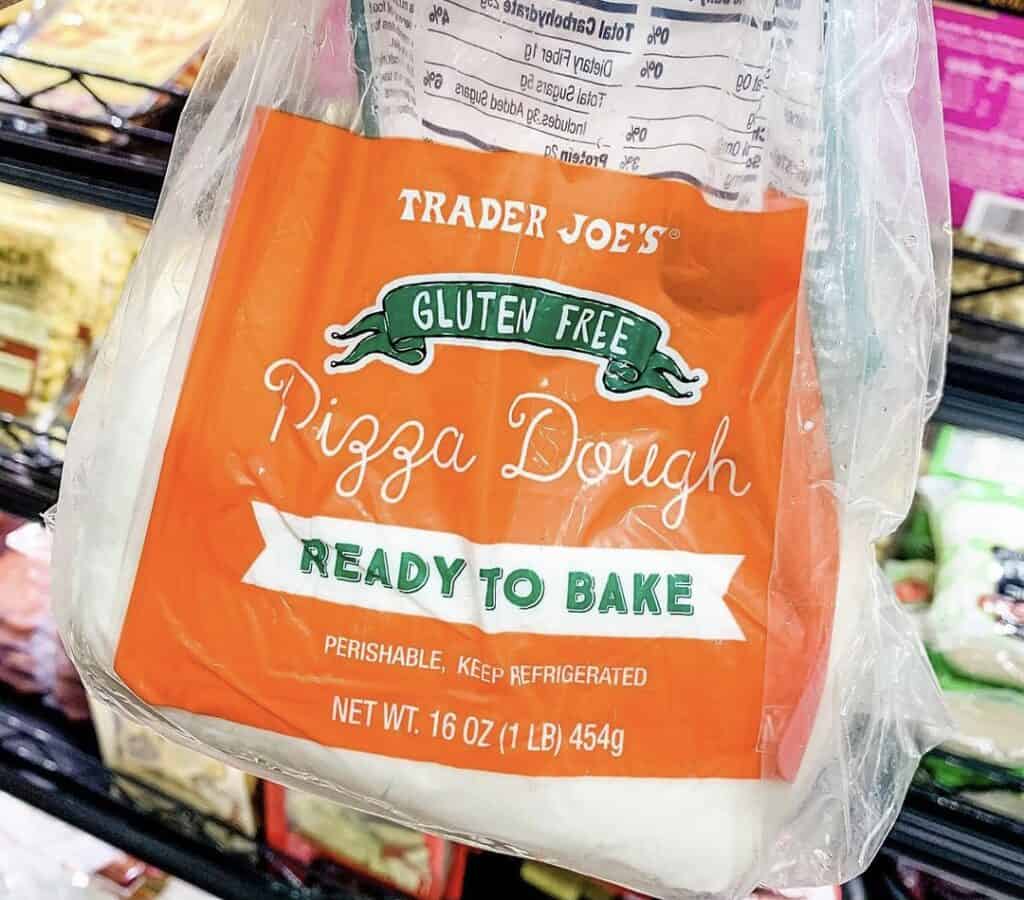
In the past few years, there’s been a lot of awareness about gluten-free food options. Gluten is a small protein that’s contained in wheat products. If you read most of your food labels, you’ll see that a wide variety of foods all contain gluten, including all-purpose flour (typically used in most pizza dough recipes).
Thankfully, they make gluten-free pizza crusts and gluten-free flour blends that you can use in place of traditional gluten-containing flour. These gluten-free pizza crusts usually substitute nut or rice-based flours such as almond flour, coconut flour, or rice flour in place of the standard wheat-based ingredients.
16. What Happens If You Don’t Let Pizza Dough Rise Enough?
Hopefully, if you read my answer to the earlier questions on proofing, then you should understand the importance of proofing your dough. Proofing is the process where you leave the dough covered in either a room temperature environment or in the refrigerator. As the dough sits, the gluten eats the wheat sugars and releases a gas, causing the dough to rise. This process is vital if you want the best-tasting pizza dough.
If you don’t follow the recipe properly and you don’t allow the dough enough time to rise, then the pizza crust will turn out chewy, tough, and bland-tasting. Giving the dough enough time to properly rise will ensure that the crust is crunchy, delicious, and has the air bubbles to give it texture.
17. Should I Use A Pizza Stone For My Pizza Dough?

If you’ve ever been to a nice pizzeria, then you may have noticed that they use large pizza stones in their ovens. The chefs typically use these as a pan to hold the pizza while it’s cooking. You can also find small personal pizza stones that are designed for use in a conventional pizza oven.
Yes, pizza stones are a great way to improve your pizza cooking game! The high-quality ceramic stones serve two purposes. The first purpose is that they help ensure that the pizza is cooked evenly. Secondly, they prevent the crust from sticking thanks to the ceramic’s natural non-stick properties.
18. How Does Yeast Work In Pizza Dough?
If it’s your first time making pizza dough, then you may be wondering how yeast works and why you need it. After all, it does sound a bit strange to people who’ve never baked bread or who know about the pizza-making process.
Yeast is a small eukaryotic organism that feeds on sugars contained within the flour. Once they’re activated with warm water, the organisms wake up and start their buffet. As they eat, they turn the sugar into alcohol and release carbon dioxide. This results in the dough rising and gives it flavor.
19. Are There Different Types of Pizza Dough Yeast?
If you’ve been shopping for yeast to make your pizza dough with, then you’ve probably realized that there are different types of yeast and different brands of yeast available on the market. So, what’s the difference between them all?
There are two types of yeast that are commonly available for making pizza dough: active dry yeast and live yeast. Active dry yeast comes in a powder and must be “woken up” with warm water. The advantage is that it keeps for longer. Live yeast typically comes in small cakes or clumps and must remain refrigerated. The shelf life of active yeast is a lot shorter (less than two weeks), so it’s not as common.
20. What’s The Difference Between Regular Pizza Dough and Sourdough?
During your research, you may have come across a few recipes for sourdough pizza. These pizzas offer a uniquely sour taste that goes well with certain toppings. It also gives the crust a unique taste that many find quite enjoyable.
The main difference between sourdough and traditional pizza dough is the type of yeast used and how long the dough ferments. Sourdough is made with “wild yeast” and typically requires up to 5 days to completely ferment. Traditional pizza dough is made with instant dry yeast and requires less than 24 hours to proof.
21. What’s The Best Way To Stretch Pizza Dough?

After your dough is finished proofing, it’s time to stretch it out into a circle so that you can add your toppings and bake your pie. The one problem that beginners run into is that the dough tends to tear or break, causing them to have to start over again.
The best way to stretch your pizza dough is to first coat the surface with a bit of olive oil or flour. Then, slowly press the ball of dough down with your palms until it’s flat. Finally, use both of your palms to work the dough outwards in a circular motion slowly. When you’re finished, you should have a wide, thin circle.
22. Why Do Pizza Makers Toss Pizza Dough?
I get this question a LOT. First-time pizza chefs tend to recall that they went to a fancy pizzeria one time and saw the chef tossing and spinning the dough in the air like an acrobat. It truly is an art form to watch. Although it’s not necessary (and beginners should probably avoid it), tossing the dough does serve a legitimate purpose other than entertainment.
As the pizza dough is tossed in the air, it naturally expands into a circular shape, which means the chef doesn’t have to spend as much time rolling, kneading, and shaping the dough. Additionally, tossing the dough creates excellent airflow which helps to dry the dough and makes it easier to handle.
23. Should You Roll Your Pizza Dough?
If you’re not used to hand-stretching your pizza dough, then you may be tempted to roll it out with a rolling pin. Rolling pins are usually an easy way to flatten and stretch the dough. However, it’s not such a good idea when dealing with pizza dough.
You should avoid rolling your pizza dough. Using a rolling pin can sometimes cause your dough to rip apart and can push out some of the air bubbles that give the dough its desired consistency. Instead, it’s best to use your hands to knead the dough out.
24. Why Do People Put Flour On The Table Before Rolling Dough?
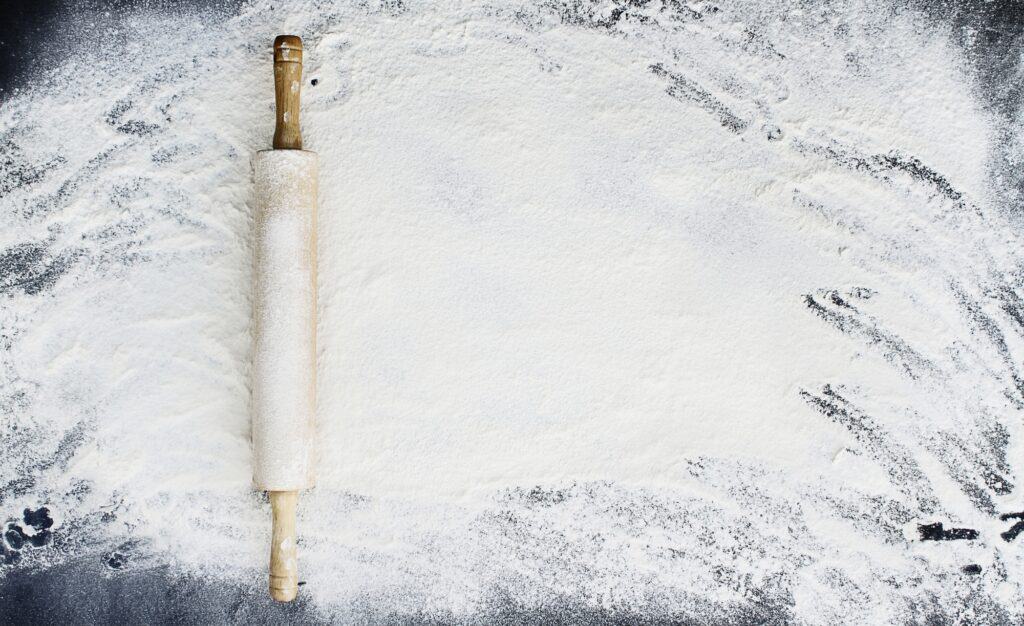
If you’ve ever spent time watching a chef roll out their pizza dough, then you may have noticed that they typically put a pinch of dry flour on the tabletop or cutting board. It may seem messy to some, but it actually serves a very important and practical purpose.
Chefs put sprinkle flour on the table before rolling or kneading the pizza due to prevent the dough from sticking. The uncooked dough is incredibly sticky by nature, and it can often stick to surfaces and rip apart. A small layer of flour “lubricates” the surface and prevents the dough from sticking.
25. Are There Preservatives In Storebought Pizza Dough?
For those of you trying to eat a healthier diet, you may be trying to avoid preservatives and other unnatural chemicals in your food. In fact, one of the best reasons to make your own pizza is that you can be 100% sure that there are no added preservatives.
If you go to a bakery and buy your own pre-made ball of dough, it probably won’t have any preservatives in it and will have a short shelf life. However, if you buy an entire frozen pizza, there’s a fairly high chance that it will have many preservatives to keep the other toppings fresh.
26. What’s The Difference Between Thin-Crust Dough and Regular Pizza Dough?
Some people love the slightly chewy, airy taste of a Neapolitan-style pizza crust. The large bubbles and thick crust makes it perfect for dipping in a side of garlic sauce or marinara. However, some people prefer ultra-crunchy thin-crust pizzas. So, what’s the difference?
Thin-crust and regular Neapolitan-style pizza dough are made the same exact way. The only difference is that thin-crust dough is stretched wider and is purposefully made to be thin. This results in fewer air bubbles and a crispier crust.
27. Why Is Pizza Dough Cooked In A Brick Oven?
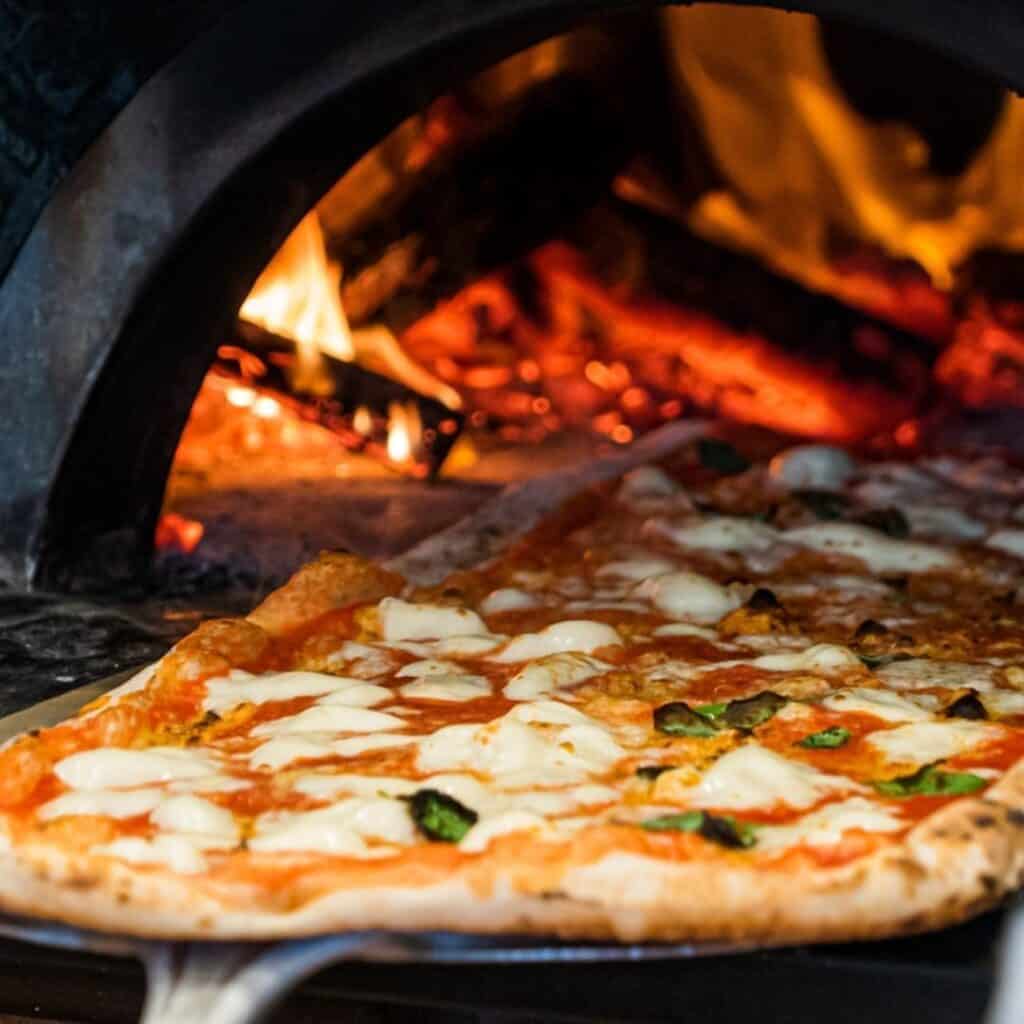
If you’ve ever been to a nice authentic pizzeria, then you may have noticed that they use large spatulas to insert and remove pizzas from a giant wood-fired brick oven. It certainly looks cool, but I’ve gotten a lot of questions as to whether or not the brick oven affects the taste or not.
Wood-fired brick ovens are used because they’re able to heat up to incredibly high temperatures of up to 1,000-degrees Fahrenheit. This allows the pizzas to cook incredibly fast. They’re typically done cooking in less than two minutes, which allows the pizzeria to produce pies faster.
28. Is It Okay To Eat Undercooked Pizza Dough?
If you’re new to cooking pizza, then you may have to work on your timing a little bit. It’s not uncommon to undercook your pizza without realizing it. But is it safe to eat undercooked dough, or can it make you sick?
Unlike other types of bread dough or cake batter (that contain eggs or milk), pizza dough doesn’t contain any ingredients that can’t be eaten raw. This means that there’s no risk of getting food poisoning. However, undercooked pizza dough can cause indigestion as it requires more work for your stomach to break down.
29. How Much Does Pizza Dough Expand When Cooked?
If you’re surprised at how much the pizza dough has expanded during the proofing process, then you may be wondering if it will get even bigger once it goes into the oven. This is why it’s always important to double-check your measurements before you put the pizza in the oven.
Pizza dough doesn’t expand much when it’s cooked in the oven. The dough does most of its expanding during the proofing process, often doubling in size. Once you put it in the oven, the raw dough will only rise incrementally as it’s cooked, so you shouldn’t have to worry about space too much.
30. Can I Freeze Pizza Dough?

Sometimes, things come up. Perhaps you had plans to cook a pizza, but then you get called into work all weekend. I’ve been in this scenario too many times to count. Thankfully, I’ve found a simple and easy solution- freezing.
You can freeze pizza dough if you need to preserve it for a longer period of time. Before freezing, you should coat the entire ball of dough in olive oil to prevent freezer burn. Then, you should tightly wrap the dough in plastic wrap or vacuum seal it to maintain freshness.
31. What Should I Do If My Pizza Dough Is Stuck To My Pizza Stone?
For the most part, pizza stones are great, and they usually prevent the pizza from sticking. However, if your pizza stone isn’t clean or has other food debris on it, then sometimes it can cause your pizza crust to stick to the stone. As long as you’re patient, though, you shouldn’t have any problem removing the pizza cleanly.
First, let the pizza cool down a bit. Then, use a pizza peel or a long spatula to slowly scrape the bottom of the pizza off the stone. Try not to make sudden, ripping movements. Instead, focus on slowly inching the pizza peel under the crust, applying gradual upward pressure.
32. How Long Does Uncooked Pizza Dough Stay Fresh?
If you ended up making a little bit too much dough or your plans suddenly change, then you’re probably concerned whether or not you can keep your dough fresh in the refrigerator. I often run into this problem and haven’t had any problem keeping my dough fresh.
Uncooked pizza dough will typically stay fresh in the refrigerator for 2 weeks. As long as you coat the dough in a light layer of olive oil to keep it dry and cover it with plastic wrap to keep the moisture locked in, then you can use your dough within 14 days of putting int the fridge.
33. Can I Cook Pizza Dough On A Grill?
So, this one time, I was out tailgating with a few buddies of mine. We all decided that we wanted a pizza but the line at the pizza stand was ridiculously long. All we had was a propane grill and a frozen pizza. In lieu of my usual oven, I had to improvise.
You can, in fact, cook a pizza on a grill. First, pre-heat the grill to 475-degrees. Then, put your pizza directly on the grate and close the lid. The pizza should take around 8 to 12 minutes to cook if it’s fresh. If it’s a frozen pizza, then the pizza may take between 15 and 18 minutes to fully cook.
34. How Long Does Pizza Dough Take To Rise?

As you proof your pizza dough, you’ll notice that the small ball you originally started with slowly starts to grow in size. By the time it’s finished proofing (rising), your ball of dough should be double or triple the size that it originally was. This is thanks to due to the natural gases released by the yeast.
How long pizza dough takes to rise depends on the temperature where the dough is being stored. In the cold, the yeast is slower and the dough will rise slower. Therefore, cold-proofing typically takes 24 hours. If you warm-proof your dough at room temperature, though, the yeast will act faster, and the dough will rise in 2 hours.
35. Why Does Pizza Dough Have Bubbles?
One of the things that set pizza dough apart from other types of bread dough is how airy and fluffy it tastes. Some pizzas even have large fist-sized bubbles popping out on the crust. This is perfectly normal and is actually a sign of a great-tasting pizza!
Pizza has bubbles, thanks to the yeast. As the yeast eats the sugar, it releases CO2 gas and causes the dough to rise. This, in turn, creates bubbles in the dough. Sometimes, these small bubbles join to create larger bubbles, giving the pizza a unique texture.
36. Is Pizza Dough Used To Make Calzones?
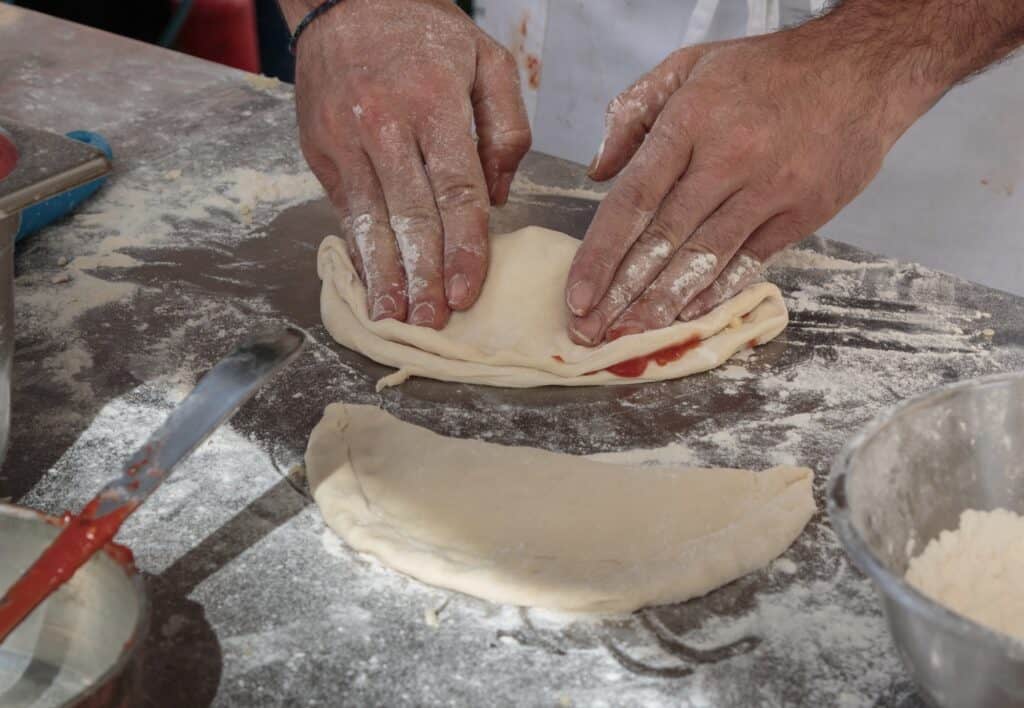
Pizza is usually my go-to. However, sometimes I do enjoy calzones, which are basically just reverse pizzas. The crust is on the outside, and all of the cheese and toppings are contained inside of the large ball of cooked dough. Is calzone dough different from pizza dough, though?
The dough used to make calzones is the same exact dough that’s used to make regular pizzas. The only difference is that the calzone dough is formed into a pocket for toppings to be inserted into instead of pressed into a circle as you’d do for a pizza.
37. Are Hot Pockets Made From Pizza Dough?
Hot Pockets are delicious little mini calzones that almost everybody’s tried at least once in their lives. They’re cheap, taste fairly decent, and only take 2 minutes to completely cook in the microwave. Are they made from real pizza dough like traditional calzones, though?
Yes, Hot Pocket crusts are made using the same process as traditional pizza and calzones. Although Hot Pocket crust is very similar to pizza dough, it contains a lot more preservatives. Additionally, the Hot Pockets are also frozen. These two factors mean that Hot Pockets don’t have as much flavor as a traditional calzone.
38. How Is Cauliflower Pizza Dough Made?
Over the past couple of years, the keto diet has exploded. This extremely low-carb diet is a great way to lose a bunch of fat really fast. However, it does require the dieter to give up all forms of bread, rice, pasta, sugar, and other simple carbohydrates. This includes pizza. In response, some dieters have been buying cauliflower crust pizzas to satisfy their cravings. So, how exactly is it made?
Cauliflower pizza crusts are relatively healthy, low-carb, and gluten-free. They’re made using ground cauliflower that’s mixed with egg and cheese which help to hold the crust together.
39. Can I Put Cold Pizza Dough In The Oven?
Avoid putting cold dough directly into the oven. When baking your homemade pizza dough, you should always allow time for the refrigerated dough to cool down to room temperature before putting it in the oven. This prevents the dough from crumbling and breaking apart.
I’ve seen first-time pizza chefs make this mistake time and time again. The worst part is that I can’t even say anything bad about it because I made this same exact mistake my first time baking a homemade pie in the oven.
40. Can They Make Pizza Dough In Space?
The other day, I had a friend ask me, “Are astronauts able to eat pizza? Can they even make pizza dough in space?” Admittedly, it was a bit of an odd question. I had never considered it before. So, me being my usual curious self, I decided to look it up.
Yes! As it turns out, in 2017, the crew of the International Space Station each managed to piece together their own personal pie in a microgravity environment. They had to velcro ingredients to a table and cook their pies in a small briefcase-sized oven, but the pizzas were real and most importantly- edible.